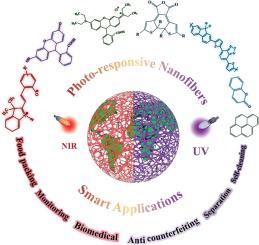当前位置:
X-MOL 学术
›
Prog. Mater. Sci.
›
论文详情
Our official English website, www.x-mol.net, welcomes your feedback! (Note: you will need to create a separate account there.)
Photo-responsive electrospun polymer nanofibers: Mechanisms, properties, and applications
Progress in Materials Science ( IF 33.6 ) Pub Date : 2024-05-18 , DOI: 10.1016/j.pmatsci.2024.101312 Milad Babazadeh-Mamaqani , Donya Razzaghi , Hossein Roghani-Mamaqani , Amin Babaie , Mostafa Rezaei , Richard Hoogenboom , Mehdi Salami-Kalajahi
Progress in Materials Science ( IF 33.6 ) Pub Date : 2024-05-18 , DOI: 10.1016/j.pmatsci.2024.101312 Milad Babazadeh-Mamaqani , Donya Razzaghi , Hossein Roghani-Mamaqani , Amin Babaie , Mostafa Rezaei , Richard Hoogenboom , Mehdi Salami-Kalajahi

|
Photo-responsive polymers have attracted increasing attention due to the unique advantages that light stimulus provides, such as high sensitivity, precise selectivity, temporal and spatial control as well as its non-aggressive nature. Photo-responsivity can be divided into different categories including fluorescence and phosphorescence emission, photochromism, variable wettability and polarity changes, photocatalysis, photodynamic therapy, photo fluidization, photothermal function, photo-induced shape memory effects, and photo-locomotion. The chemical integration or physical doping of the photo-responsive compounds to a polymer matrix could induce such photo-responsivity to the host polymers. In recent years, electrospinning has been used as an effective method to fabricate photo-responsive electrospun nanofibrous mats with improved photo-responsive functionalities due to their porous structure with a high surface-to-volume ratio. This review focuses on the recent developments in photo-responsive electrospun polymer nanofibers. The preparation methods and electrospinning parameters, incorporated photo-responsive compounds, photo-responsive mechanisms, and the application areas of the photo-responsive electrospun nanofibrous mats are covered in detail. In this review, the recent studies on photo-responsive polymer nanofibers will be discussed and arranged based on their application types, such as monitoring and sensing, food packaging, anticounterfeiting, drug delivery, wound healing, bioactivity, membranes, and self-cleaning. Moreover, new strategies are proposed for each application field for the future studies to prepare multi-functional electrospun nanofibers with different morphologies, such as layer-by-layer, core-shell, and Janus nanofibers. It is believed that this review may provide new horizons in the preparation of new photo-responsive electrospun polymer nanofibers with smart applications.
中文翻译:

光响应静电纺聚合物纳米纤维:机理、性能和应用
光响应聚合物由于光刺激提供的独特优势,如高灵敏度、精确选择性、时间和空间控制以及其非攻击性而引起了越来越多的关注。光响应性可分为不同的类别,包括荧光和磷光发射、光致变色、可变润湿性和极性变化、光催化、光动力疗法、光流化、光热功能、光诱导形状记忆效应和光运动。光响应性化合物与聚合物基质的化学整合或物理掺杂可以诱导对主体聚合物的这种光响应性。近年来,静电纺丝已被用作制造光响应电纺纳米纤维垫的有效方法,由于其具有高表面积与体积比的多孔结构,该纳米纤维垫具有改进的光响应功能。本文重点介绍光响应静电纺聚合物纳米纤维的最新进展。详细介绍了光响应电纺纳米纤维垫的制备方法和静电纺丝参数、掺入的光响应化合物、光响应机制以及应用领域。在这篇综述中,将根据光响应聚合物纳米纤维的应用类型,如监测和传感、食品包装、防伪、药物输送、伤口愈合、生物活性、膜和自清洁等,对最近关于光响应聚合物纳米纤维的研究进行讨论和整理。此外,还针对每个应用领域提出了新的策略,以供未来研究制备具有不同形貌的多功能静电纺纳米纤维,例如层层纳米纤维、核壳纳米纤维和Janus纳米纤维。 相信这篇综述可能为制备具有智能应用的新型光响应静电纺聚合物纳米纤维提供新的视野。
更新日期:2024-05-18
中文翻译:

光响应静电纺聚合物纳米纤维:机理、性能和应用
光响应聚合物由于光刺激提供的独特优势,如高灵敏度、精确选择性、时间和空间控制以及其非攻击性而引起了越来越多的关注。光响应性可分为不同的类别,包括荧光和磷光发射、光致变色、可变润湿性和极性变化、光催化、光动力疗法、光流化、光热功能、光诱导形状记忆效应和光运动。光响应性化合物与聚合物基质的化学整合或物理掺杂可以诱导对主体聚合物的这种光响应性。近年来,静电纺丝已被用作制造光响应电纺纳米纤维垫的有效方法,由于其具有高表面积与体积比的多孔结构,该纳米纤维垫具有改进的光响应功能。本文重点介绍光响应静电纺聚合物纳米纤维的最新进展。详细介绍了光响应电纺纳米纤维垫的制备方法和静电纺丝参数、掺入的光响应化合物、光响应机制以及应用领域。在这篇综述中,将根据光响应聚合物纳米纤维的应用类型,如监测和传感、食品包装、防伪、药物输送、伤口愈合、生物活性、膜和自清洁等,对最近关于光响应聚合物纳米纤维的研究进行讨论和整理。此外,还针对每个应用领域提出了新的策略,以供未来研究制备具有不同形貌的多功能静电纺纳米纤维,例如层层纳米纤维、核壳纳米纤维和Janus纳米纤维。 相信这篇综述可能为制备具有智能应用的新型光响应静电纺聚合物纳米纤维提供新的视野。












































 京公网安备 11010802027423号
京公网安备 11010802027423号